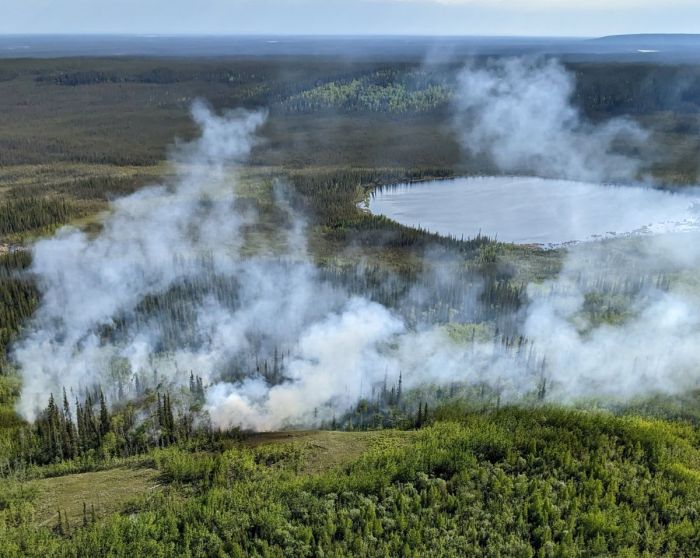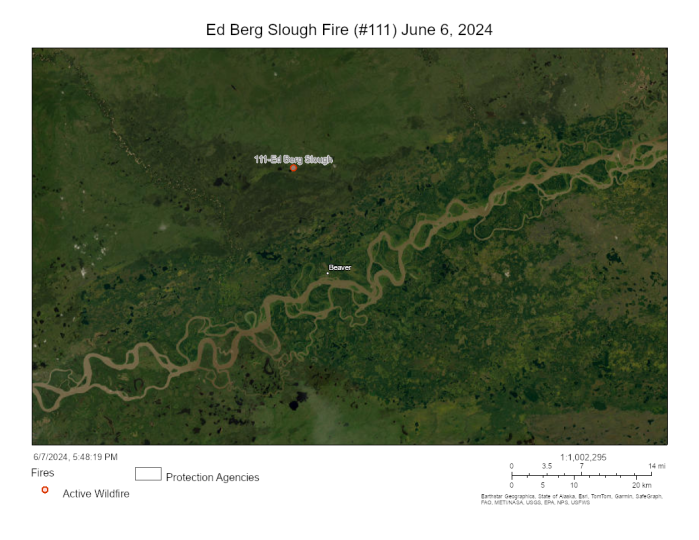
(FAIRBANKS, Alaska) — Smokejumpers and the North Star Fire Crew are working on a small fire burning about 11 miles north of Beaver.
9 a.m. Saturday, June 8 update: Firefighters contained the fire on Friday – meaning they established a line around a fire to prevent it from spreading. Containment doesn’t necessarily mean the fire is out, but rather how much of the perimeter has been secured. Six of the eight smokejumpers will demobilize from the fire today, leaving two smokejumpers and the North Star Fire Crew to mop up hotspots to fully extinguish the fire.
More people are headed out to Fort Yukon Saturday to support the work that is being done on this fire.
Original information posted on Friday: The Ed Berg Slough Fire (#111) was reported by a commercial pilot Wednesday afternoon. Eight smokejumpers were deployed shortly after and reported the fire was burning in a mixture of hardwoods and spruce, tundra and brush within the Yukon Flats National Wildlife Refuge about 114 miles north of Fairbanks. It’s estimated to have burned just under 3 acres.
The North Star Fire Crew – BLM Alaska Fire Service’s training crew – mobilized to the fire Thursday afternoon and was busying trying to get a fire line around the perimeter to help keep it from growing. Once completed, the firefighters will then start mopping up – meaning they’ll be searching for hotspots to extinguish. The goal is to have all hotspots full extinguished and call the fire out.
It is located less than half a mile from an area that was identified as containing Yedoma permafrost, a specific type of carbon and ice-rich permafrost formed during the Ice Age. In 2023, 1.6 million acres of the refuge was changed from limited to modified management option to provide some protection of the Yedoma permafrost. These management options drive initial response, but still allow for flexibility as fires develop and are assessed, so that subsequent decisions about strategy and resource allocation are made based on the current situation regardless of management option. The modified option will generate a suppression response early in the season while limited is designed to allow for fire to function in its natural ecological role.
The Ed Berg Slough Fire also provides a good training opportunity for the North Star Fire Crew to get experience to set them up for the remainder of the fire season.

It’s one of two staffed fires and one of 25 actives fires in Alaska. As of 5 p.m. Friday, 109 fires have burned 6,759 acres this year. That is anticipated to increase with the red flag conditions throughout much of central and Interior Alaska this weekend. The Yukon Flats, which also falls within the red flag area, has already experienced several days of hot, dry and even a few days of windy weather. BLM AFS will have several flights scheduled to detect any new fires over the weekend.
People living in Fort Yukon may have noticed activity at BLM AFS’s fire station in the Yukon River community. A helicopter and a handful of people are operating out of the turn-key station in support of this fire and possibly more in the Yukon Flats area due to forecasted hot and dry conditions.
To help firefighters out, please be careful while you’re out enjoy the nice weather. Take precautions to not start a fire. Adhere to Alaska Division of Forestry & Fire Protection burn permit suspensions in Interior Alaska. Please note that cooking and warming fires are still allowed but extreme caution must be used due to high wildfire potential. Never leave a fire unattended and make sure it’s completely cold to the touch before leaving.
You can also find more information about the Forestry burn permit program and suspensions at https://dnr.alaska.gov/burn.
Contact BLM AFS Public Affairs Specialist Beth Ipsen at (907)356-5510 or eipsen@blm.gov for more information.
###
Bureau of Land Management, Alaska Fire Service, P.O. Box 35005 1541 Gaffney Road, Fort Wainwright, Ak 99703
Need public domain imagery to complement news coverage of the BLM Alaska Fire Service in Alaska? Visit our Flickr channel!
Learn more at www.blm.gov/AlaskaFireService, and on Facebook and Twitter.
The Bureau of Land Management Alaska Fire Service (AFS) located at Fort Wainwright, Alaska, provides wildland fire suppression services for over 240 million acres of Department of the Interior and Native Corporation Lands in Alaska. In addition, AFS has other statewide responsibilities that include: interpretation of fire management policy; oversight of the BLM Alaska Aviation program; fuels management projects; and operating and maintaining advanced communication and computer systems such as the Alaska Lightning Detection System. AFS also maintains a National Incident Support Cache with a $18.1 million inventory. The Alaska Fire Service provides wildland fire suppression services for America’s “Last Frontier” on an interagency basis with the State of Alaska Department of Natural Resources, USDA Forest Service, National Park Service, Bureau of Indian Affairs, U.S. Fish and Wildlife Service, and the U.S. Military in Alaska.
Categories: Active Wildland Fire, AK Fire Info, BLM Alaska Fire Service